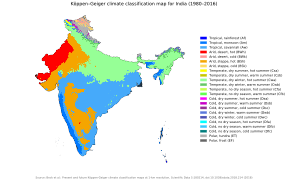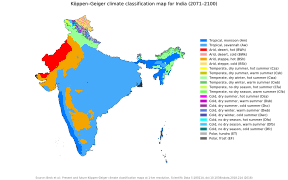Climate change in India

Indiawas ranked seventh among the list of countries most affected byclimate changein 2019.[1]India emits about 3 gigatonnes (Gt)CO2eqofgreenhouse gaseseach year; about two and a half tons per person, which is less than the world average.[2]The country emits 7% of global emissions, despite having 17% of the world population.[3]Theclimate change performance indexof India ranks eighth among 63 countries which account for 92% of all GHG emissions in the year 2021.[4]
Temperature rises on theTibetan Plateauare causingHimalayan glaciers to retreat,threatening the flow rate of theGanges,Brahmaputra,Yamunaand other major rivers. A 2007World Wide Fund for Nature(WWF) report states that theIndus Rivermay run dry for the same reason.[5]Severe landslides and floods are projected to become increasingly common in such states asAssam.[6]Heat waves' frequency and intensity are increasing in India because of climate change.[7]Temperatures in India have risen by 0.7 °C (1.3 °F) between 1901 and 2018.[8]
According to some current projections, the number and severity ofdroughts in Indiawill have markedly increased by the end of the present century.[9]
Greenhouse gas emissions
[edit]

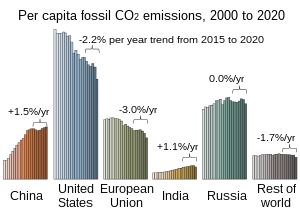
Greenhouse gas emissionsbyIndiaare the third largest in the world and the main source is coal.[11]India emitted 2.8 Gt ofCO2eqin 2016 (2.5 includingLULUCF).[12][13]79% were CO2,14% methane and 5%nitrous oxide.[13]India emits about 3 gigatonnes (Gt)CO2eqofgreenhouse gaseseach year; about two tons per person,[14]which is half the world average.[2]The country emits 7% of global emissions.[3]
In India in 2023, emissions increased by 190 million tonnes due to strong GDP growth and reducedhydroelectricityproduction following a weak monsoon, with itsper capita emissionsremaining significantly below the global average.[15]
Cutting greenhouse gas emissions, and thereforeair pollution in India,would have health benefits worth 4 to 5 times the cost, which would be the most cost-effective in the world.[16]
TheParis Agreementcommitments included a reduction of this intensity by 33–35% by 2030.[17]India's annual emissions per person are less than the global average,[18]and theUNEPforecasts that by 2030 they will be between 3 and 4 tonnes.[3]
In 2019 China is estimated to have emitted 27% of world GhG, followed by the US with 11%, then India with 6.6%.[19]
TheIndian national carbon trading schememay be created in 2026.[20]
Electricity generation
[edit]As of September 2021 India generates 39.8% of its electricity fromrenewable energysources and 60.2% of its electricity fromfossil fuelsof which 51% is generated from coal.[21]
Coal fired power stations
[edit]As well ascoal mining in India,the country also imports coal[22]to burn incoal-fired power stations in India.New plants are unlikely to be built, old and dirty plants may be shut down and more coal may be burnt in the remaining plants.[23]
Household fuel
[edit]Switching from traditional fuels toliquefied petroleum gasand electricity provides health and climate benefits.[24]
Industry
[edit]The industrial sector, including the production of cement,[25]iron, and steel,[26]is a major contributor to global emissions, accounting for about a quarter of the total.[27]From 2000 to 2014, fuel consumption in this sector surged by 406%,[17]reflecting its rapid expansion and escalating energy demand. By 2014, the industry was also responsible for 42% of total energy consumption,[17]highlighting the significant environmental impacts associated with industrial activities. India, the world's second-largest steel producer, accounts for 7% of global crude steel production. With rising domestic demand, emissions from this sector could significantly increase. Implementing standards for low and near-zero emissions steel is crucial to mitigate this risk. These standards facilitate essential policies and mechanisms such as procurement, financing,carbon pricing,and emissions trading systems, which are key in supporting India's transition tonet-zero emissionsand reducing theenvironmental impactsof its industrial sector.[28]
Agriculture
[edit]Agricultural emissions increased 25% between 2005 and 2014, in part due to significant increases in the use of artificial fertilizers and the burning of crops.[17]
Waste
[edit]Waste emitted 78 Mt ofCO2eqin 2014.[26]
Impacts on the natural environment
[edit]Temperature and weather changes
[edit]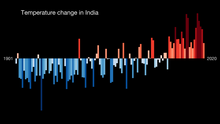
Temperatures in India have risen by 0.7 °C (1.3 °F) between 1901 and 2018, thereby changing theclimate in India.[32]
In May 2022 severe heatwave was recorded in Pakistan and India. The temperature reached 51 °C. Climate change makes such heatwaves 100 times more likely. Without climate change heatwaves, more severe that those who occurred in 2010 are expected to arrive 1 time in 312 years. Now they are expected to occur every 3 years.[33]
A 2018 study projects droughts to increase in Northern and North-western India in the near future. Around the end of the century, most parts of India will likely face more and more severe droughts.[34]
Severe landslides and floods are projected to become increasingly common in such states as Assam.[6]
Sea level rise
[edit]
Meghalaya and other northeastern states are concerned that rising sea levels will submerge much of Bangladesh and spawn a refugee crisis. If severe climate changes occurs, Bangladesh and parts of India that border it may lose vast tracts of coastal land.[35]: 130
Thousands of people have been displaced by ongoing sea level rises that have submerged low-lying islands in theSundarbans.[36]
Water resources
[edit]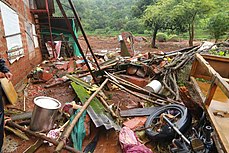
Temperature rises on the Tibetan Plateau are causingHimalayan glaciers to retreat,threatening theflow rateof the Ganga, Brahmaputra,Yamuna,and other major rivers; the livelihoods of hundreds of thousands of farmers depend on these rivers.[37]A 2007World Wide Fund for Nature(WWF) report states that theIndus Rivermay run dry for the same reason.[5]
Ecosystems
[edit]Ecological disasters, such as a 1998coral bleachingevent that killed off more than 70% of corals in the reef ecosystems offLakshadweepand theAndamansand was brought on by elevated ocean temperatures tied to global warming, are also projected to become increasingly common.[38][39]
Impacts on people
[edit]Economic impacts
[edit]India has the world's highestsocial cost of carbon.[40]A report by the London-based global think tankOverseas Development Institutefound that India may lose anywhere around 3–10% of its GDP annually by 2100 and its poverty rate may rise by 3.5% in 2040 due to climate change.[41][42]
Reduced crop yields
[edit]Climate Change in India will have a disproportionate impact on the more than 400 million that makeup India's poor community. This is because so many depend on natural resources for their food, shelter and income. More than 56% of people in India work in agriculture, while many others earn their living in coastal areas.[43] The impact of climate change onIndian agriculturewas investigated through the National Innovations in Climate Resilient Agriculture (NICRA) study. The findings indicate that rainfed rice yields in India are expected to experience a marginal reduction of less than 2.5% in the years 2050 and 2080. On the other hand, irrigated rice yields are projected to decline by 7% in 2050 and 10% in 2080 scenarios. Moreover, the study forecasts a decrease in wheat yield ranging from 6% to 25% in the year 2100, while maize yields are estimated to decrease by 18% to 23% during the same period. However, there is a potential positive impact on chickpea, with anticipated productivity increases of 23% to 54% in the future climates.[44]
Health impacts
[edit]Air pollution,which reflects sunlight, and irrigation, which cools the air by evaporation, have counteractedclimate changesince 1970. These two factors do however increase the impact of heat waves, as both lead to increased mortality.[45]
Heat waves
[edit]
Heat waves' frequency and power are increasing in India because of climate change. In 2019, the temperature reached 50.6 degrees Celsius, 36 people were killed. The high temperatures are expected to impact 23 states in 2019, up from nine in 2015 and 19 in 2018. The number of heat wave days has increased—not just day temperature, night temperatures increased also. 2018 was the country's sixth hottest year on record, and 11 of its 15 warmest years have occurred since 2004. The capitalNew Delhibroke its all-time record with a high of 48 degrees Celsius.[46]
In India, exposure to heat waves is said to increase by 8 times between 2021 and 2050, and by 300% by the end of this century. The number of Indians exposed to heat waves increased by 200% from 2010 to 2016. Heat waves also affect farm labour productivity. The heat waves affect central and northwestern India the most, and the eastern coast andTelanganahave also been affected. In 2015, the latter places witnessed at least 2500 deaths. In 2016, for the first time in history,Keralareported a heat wave. The government is being advised by theIndian Institute of Tropical Meteorologyin predicting and mitigating heat waves. The government ofAndhra Pradesh,for instance, is creating a Heat Wave Action Plan.[47]
The death toll from India's heat waves has decreased in the last four years. More than 2,000 people died in2015,375 in 2017 and 20 in 2018. "Officials say this is because the government has made an effort to reduce the death toll by encouraging residents to reduce or alter the time spent working on hot days and by providing free drinking water to hard-hit populations". It also used water to cool streets and forced police to guard water tankers inMadhya Pradeshstate after fights over supply turned deadly. Those measures cost a lot of money and water, and the government's resources were limited in 2019 by the country's national election. The heat wave may continue, as monsoon rains have been delayed this year.[48][needs update]
Impacts on migration
[edit]Around seven million people are projected to be displaced due to, among other factors, submersion of parts ofMumbaiandChennai,if global temperatures were to rise by 2 °C (3.6 °F).[49]
By the year 2050, India is expected to witness a significant increase in climate-related displacement, with around 45 million people compelled to migrate from their homes due to climate disasters. This number is three times higher than the current count of individuals being displaced because of extreme weather events. According to the "State of India's Environment-2022" report,Indiaranks as the fourth worst-affected country globally in terms of climate change-induced migration, with over three million people forced to abandon their residences in the year 2020-2021. These statistics emphasize the escalating impact of climate change on migration patterns within the country.[50]
Villagers in India's North Eastern state ofMeghalayaare also concerned that rising sea levels will submerge neighboring low-lying Bangladesh, resulting in an influx of refugees into Meghalaya which has few resources to handle such a situation.[51][52]
Mitigation
[edit]
Greenhouse gas sinks
[edit]Land use, land-use change, and forestryabsorbed 300 Mt ofCO2eqin 2014[26]and in 2020 total carbon stored in forests was 7000 Mt.[53]
Energy policy
[edit]The National Energy Plan is in accord with theParis Agreementtarget of 2 °C global warming, but if India stopped building coal-fired power stations it would meet the 1.5 °C aspiration.[54]India pledged to achieve electric power generation of 40% percent non-fossil fuel energy by 2030.[17]
In its Biennial Update Report to the United Nations Framework Convention on Climate Change (UNFCCC) submitted in February, India said it has progressively continued decoupling of economic growth from greenhouse gas emissions. India'semission intensityof gross domestic product (GDP) has reduced by 24% between 2005 and 2016. India is therefore on track to meet its voluntary declaration to reduce theemission intensityof GDP by 20–25% from 2005 levels by 2020, making India the onlyG20nation to meet climate goals.[55]
India'sIntended Nationally Determined Contributionincludes reducingemission intensityby a third by 2030.[11]India has adequate carbon neutral resources such as biomass, wind, solar, hydro power includingpumped storage,etc. to achieve net zero carbon emissions.[56][57]
With accelerated coal plant closures, and an anticipated surge in renewables, thermal power will account for only an estimated 42.7% of installed capacity across India by 2027, down dramatically from 66.8% in 2017.[58]
Cutting greenhouse gas emissions, and thereforeair pollution in India,would have health benefits worth 4 to 5 times the cost, which would be the most cost-effective in the world.[16]
India has made significant strides in theenergy sectorand the country is now a global leader inrenewable energy.[59]
Policies and legislation
[edit]The Indian Government as well as various state governments have taken certain steps in accordance with India's energy policy and theParis Agreement.Following are some of those steps:
- Doubling India's renewable energy target to 450 gigawatt (GW) by 2030[60]
- National Solar Mission
- Wind power in India
In 2008, India published itsNational Action Plan on Climate Change(NAPCC), which contains several goals for the country. These goals include but are not limited to: covering one third of the country with forests and trees, increasing renewable energy supply to 6% of total energy mix by 2022, and the further maintenance ofdisaster management.All of the actions work to improve the resiliency of the country as a whole, and this proves to be important because India has an economy closely tied to its natural resource base and climate-sensitive sectors such as agriculture, water, and forestry.[61]
While presenting the fiscal year 2020-2021 state budget for the Indian state ofOdisha,Finance Minister of the state Niranjan Pujari introduced the Climate Budget.[62]Climate budget aims to keep track of the expenses made by the government for climate change or to support mitigation and adaption actions to address climate change. As per the document, It will help the government to decide whether to redesign or safeguard the existing projects by seeing their impact on the climate change.[63]Odisha has become the first state in India to introduce climate budget.[64]
Niti Aayogis in the process of devising a policy framework and its deployment mechanism in India for carbon capture and utilization or storage (CCUS) to reduce greenhouse emissions per unit of economic activity.[65]
The right "to be free from adverse impacts of climate change" was legally recognized as a fundamental right in India by the Supreme Court, in 2024. This decision can impact further climate legislation in India.[66]
For achieving the aims of theParis agreementIndia must peak power sector emissions by 2026. Until recently the country was expected to reach this target, but the recent governmental push for coal undermined it. [67]
Carbon emission trading and pricing
[edit]Carbon emission tradingis yet to be implemented in India. However, related instruments such as energy saving certificates (PAT), various renewable purchase obligations (RPO), and renewable energy certificates (REC) are traded on the power exchanges regularly.[68][69]
India does not have acarbon tax,but since 2010 the country has had a tax on both domestically produced and imported coal, which powers more than half of its electricity generation.[70]Originally set at₹50(60¢ US) per tonne of coal, it was raised to ₹100 in 2014[71]and ₹200 in 2015. As of 2020 the coal tax stands at₹400(US$4.80) per tonne.[72]
International cooperation
[edit]
As a party to theParis AgreementIndia is due to submit its first biennial transparency report to theUNFCCCby 2024 and inventory figures in standard format.[73]In September 2021 India announced that it will submit a newNationally Determined ContributionbeforeCOP26.[74]At COP26, India set the latest target date planning to be net-zero by 2070.[75][76][77]This was the first time in that a date forcarbon neutralityhas been given as part of India's climate policy.[78]
AtCOP26Indian prime minister Narendra Modi announced 5 main commitments calledPanchamrit– "India's gift to the world":
- Reaching carbon neutrality by 2070.
- Expand the energy capacity not coming from fossil fuels to 500GW by 2030.
- Cut the carbon intensity of economy by 45% by 2030.
- Draw half of its energy requirement from renewable sources by 2030.
- Cut 1 billion tons of GHG emission from the amount projected to the year 2030.
The prime minister also proposed to advance a new agenda: LIFE - Lifestyle for Environment, meaning changing lifestyle for benefit the environment.[79]
Even though the date of net zero is far behind that of China and the US and India's government wants to continue with the use of coal, Indian environmentalists and economists applauded the decision, describing it as a bold climate action.[80]
Adaptation
[edit]AnIce Stupadesigned bySonam Wangchukbrings glacial water to farmers in the Himalayan Desert of Ladakh, India.[81]
A research project conducted between 2014 and 2018 in the five districts (Puri, Khordha, Jagatsinghpur, Kendrapara and Bhadrak) of Mahanadi Delta, Odisha and two districts (North and South 24 Parganas) of Indian Bengal Delta (includes the Indian Sundarbans), West Bengal provides evidence on the kinds ofadaptationspracticed by the delta dwellers. In the Mahanadi delta, the top three practiced adaptations were changing the amount of fertiliser used in the farm, the use of loans, and planting of trees around the homes. In the Indian Bengal Delta, the top three adaptations were changing the amount of fertiliser used in the farm, making changes to irrigation practices, and use of loans. Migration as an adaptation option is practiced in both these deltas but is not considered as a successful adaptation.[82]
In the Indian Sundarbans of West Bengal, farmers are cultivating salt-tolerant rice varieties which have been revived to combat the increasing issue of soil salinity. Other agricultural adaptations include mixed farming, diversifying crops, rain water harvesting, drip irrigation, use of neem-based pesticide, and ridge and farrow land shaping techniques where "the furrows help with drainage and the less-saline ridges can be used to grow vegetables". These have helped farmers to grow a second crop of vegetables besides the monsoon paddy crop.[83]
In Puri district of Odisha, water logging is a hazard that affects people yearly. In the Totashi village, many women are turning the "water logging in their fields to their advantage" by cultivating vegetables in the waterlogged fields and boosting their family income and nutrition.[84]
Education is an integral tool that can be used in the adaptation of the measures that have been put in place to curb climate change. When considering the adaptation of measures that have been established to curb climate change, it is important to ensure that the education system has been included in such a project. By improving people's knowledge of climate change, it would be easier for them to adopt different mitigation measures. Also, there is a need to instill a culture among the younger generation on the best practices when it comes to environmental matters. The government must seek to ensure that systems that support learning, which undergirds adaptation are supported to enhance adaptation.
Society and culture
[edit]Media coverage
[edit]A qualitative analysis of some mainstream Indian newspapers (particularly opinion and editorial pieces) during the release of theIPCC 4th Assessment Reportand during theNobel Peace Prizewin byAl Goreand the IPCC found that Indian media strongly pursue the frame ofscientific certaintyin their coverage of climate change.[85]This is in contrast to theskepticismdisplayed by American newspapers at the time. Alongside, Indian media highlight frames of energy challenge, social progress, public accountability and looming disaster. This sort of coverage finds parallels in European media narratives as well and helps build a transnational, globalized discourse on climate change.[86]Another study has found that the media in India are divided along the lines of a north–south, risk-responsibility discourse.[87][clarification needed][obsolete source]
Activism
[edit]
Calculations in 2021 showed that, for giving the world a 50% chance of avoiding a temperature rise of 2 degrees or more India should increase its climate commitments by 55%.[88]: Table 1 For a 95% chance it should increase the commitments by 147%. For giving a 50% chance of staying below 1.5 degrees India should increase its commitments by 191%.[88]
There have beenschool strikes for climateorganised by activists such asDisha Ravi.[89]
Tribal people in India's remote northeast planned to honor former U.S. Vice PresidentAl Gorein 2007 with an award for promoting awareness on climate change that they say will have a devastating impact on their homeland.[90]
Meghalaya- meaning 'Abode of the Clouds' inHindi—is home to the towns ofCherrapunjiandMawsynram,which are credited with being the wettest places in the world due to their high rainfall. But scientists state that global climate change is causing these areas to experience an increasingly sparse and erratic rainfall pattern and a lengthened dry season,[91]affecting the livelihoods of thousands of villagers who cultivate paddy and maize. Some areas are also facing water shortages.[citation needed]
People are becoming aware of the ills of global warming. Taking initiative on their own people from Sangamner, Maharashtra (near Shirdi) have started a campaign of planting trees known as Dandakaranya- The Green Movement. It was started by visionary & ace freedom fighter the late Shri Bhausaheb Thorat in 2005. To date, they have sowed more than 12 million seeds & planted half a million plants.[citation needed]
See also
[edit]- Climate change adaptation
- Climate change mitigation
- Climate finance
- Plug-in electric vehicles in India
- Climate change in South Asia
References
[edit]- ^Eckstein, David; Künzel, Vera; Schäfer, Laura (January 2021)."Global Climate Risk Index 2021"(PDF).GermanWatch.org.
- ^ab"Greenhouse Gas Emissions in India"(PDF).September 2018.Archived(PDF)from the original on 2020-02-14.Retrieved10 June2021.
- ^abc"Emissions Gap Report 2019".UN Environment Programme.2019.Archivedfrom the original on 2019-11-20.Retrieved10 June2021.
- ^"Climate Change Performance Index"(PDF).November 2022.Retrieved15 November2022.
- ^ab"How climate change hits India's poor".BBC News.1 Feb 2007.Retrieved10 June2021.
- ^ab"Warmer Tibet can see Brahmaputra flood Assam | India News - Times of India".The Times of India.3 February 2007.Retrieved2021-03-11.
- ^Coleman, Jude (2024-05-29)."Chance of heatwaves in India rising with climate change".Nature.doi:10.1038/d41586-024-01577-5.PMID38811783.
- ^Sharma, Vibha (15 June 2020)."Average temperature over India projected to rise by 4.4 degrees Celsius: Govt report on impact of climate change in country".Tribune India.Retrieved30 November2020.
- ^Gupta, Vivek; Jain, Manoj Kumar (2018)."Investigation of multi-model spatiotemporal mesoscale drought projections over India under climate change scenario".Journal of Hydrology.567:489–509.Bibcode:2018JHyd..567..489G.doi:10.1016/j.jhydrol.2018.10.012.ISSN0022-1694.S2CID135053362.
- ^abFriedlingstein, Pierre; Jones, Matthew W.; O'Sullivan, Michael; Andrew, Robbie M.; Hauck, Judith; Peters, Glen P.; Peters, Wouter; Pongratz, Julia; Sitch, Stephen; Le Quéré, Corinne; Bakker, Dorothee C. E. (2019-12-04)."Global Carbon Budget 2019".Earth System Science Data.11(4): 1783–1838 (Table 7).Bibcode:2019ESSD...11.1783F.doi:10.5194/essd-11-1783-2019.hdl:20.500.11850/385668.ISSN1866-3516.
- ^ab"The Carbon Brief Profile: India".Carbon Brief.2019-03-14.Retrieved2019-09-25.
- ^Government of India (2018)India Second Biennial Update Report to the United Nations Framework Convention on Climate Change
- ^ab"India: Third Biennial Update Report to The United Nations Framework Convention on Climate Change"(PDF).Archived(PDF)from the original on 2021-02-27.
- ^"By 2030, Cut Per Capita Emission to Global Average: India to G20".The Leading Solar Magazine In India.26 July 2021.Retrieved2021-09-17.
- ^"CO2Emissions in 2023 – Analysis ".IEA.March 2024.Retrieved2024-03-22.
- ^abSampedro, Jon; Smith, Steven J.; Arto, Iñaki; González-Eguino, Mikel; Markandya, Anil; Mulvaney, Kathleen M.; Pizarro-Irizar, Cristina; Van Dingenen, Rita (2020-03-01)."Health co-benefits and mitigation costs as per the Paris Agreement under different technological pathways for energy supply".Environment International.136:105513.Bibcode:2020EnInt.13605513S.doi:10.1016/j.envint.2020.105513.hdl:10810/44202.ISSN0160-4120.PMID32006762.
- ^abcde"Greenhouse Gas Emissions Factsheet: India".Climatelinks.31 January 2019.Retrieved2020-04-23.
- ^Roche, Elizabeth (2021-09-05)."India, US to focus on financing green technologies during John Kerry's visit".mint.Retrieved2021-09-17.
- ^"Report: China emissions exceed all developed nations combined".BBC News.2021-05-07.
- ^Agrawal, Parth Kumar,Manas (2024-09-16)."India to get its own carbon market".Down To Earth.Retrieved2024-09-27.
{{cite web}}:CS1 maint: multiple names: authors list (link) - ^"Power Sector at a Glance: All India | Government of India | Ministry of Power".Powermin.gov.in.Retrieved2022-08-11.
- ^"India, World's No. 2 Coal Buyer, Plans to Cut Imports by a Third".Bloomberg.August 2019.Retrieved2019-09-27.
- ^"How Long Will Coal Remain King in India?".greentechmedia.Retrieved2021-01-21.
- ^Maji, Poushali; Kandlikar, Milind (2020-04-01)."Quantifying the air quality, climate and equity implications of India's household energy transition".Energy for Sustainable Development.55:37–47.Bibcode:2020ESusD..55...37M.doi:10.1016/j.esd.2019.11.006.ISSN0973-0826.S2CID212937766.
- ^Balsara, Sachin; Jain, P. K.; Ramesh, Anbanandam (2020)."Analyzing Enablers of Emission Reduction Strategies of Cement-manufacturing Industry of India under Fuzzy Environment".In Shunmugam, M. S.; Kanthababu, M. (eds.).Advances in Simulation, Product Design and Development.Lecture Notes on Multidisciplinary Industrial Engineering. Singapore: Springer. pp. 571–581.doi:10.1007/978-981-32-9487-5_47.ISBN978-981-329-487-5.S2CID209766770.
- ^abc2nd biennial report (2018),p. 8.
- ^"India's Industrial Sector GHG Emissions".ghgplatform-india.org.Retrieved2020-04-20.
- ^"Standards for a net zero iron and steel sector in India – Analysis".IEA.2024-04-26.Retrieved2024-05-05.
- ^Hausfather, Zeke; Peters, Glen (29 January 2020)."Emissions – the 'business as usual' story is misleading".Nature.577(7792): 618–20.Bibcode:2020Natur.577..618H.doi:10.1038/d41586-020-00177-3.PMID31996825.
- ^Schuur, Edward A.G.; Abbott, Benjamin W.; Commane, Roisin; Ernakovich, Jessica; Euskirchen, Eugenie; Hugelius, Gustaf; Grosse, Guido; Jones, Miriam; Koven, Charlie; Leshyk, Victor; Lawrence, David; Loranty, Michael M.; Mauritz, Marguerite; Olefeldt, David; Natali, Susan; Rodenhizer, Heidi; Salmon, Verity; Schädel, Christina; Strauss, Jens; Treat, Claire; Turetsky, Merritt (2022)."Permafrost and Climate Change: Carbon Cycle Feedbacks From the Warming Arctic".Annual Review of Environment and Resources.47:343–371.doi:10.1146/annurev-environ-012220-011847.
Medium-range estimates of Arctic carbon emissions could result from moderate climate emission mitigation policies that keep global warming below 3°C (e.g., RCP4.5). This global warming level most closely matches country emissions reduction pledges made for the Paris Climate Agreement...
- ^Phiddian, Ellen (5 April 2022)."Explainer: IPCC Scenarios".Cosmos.Archivedfrom the original on 20 September 2023.Retrieved30 September2023.
"The IPCC doesn't make projections about which of these scenarios is more likely, but other researchers and modellers can.The Australian Academy of Science,for instance, released a report last year stating that our current emissions trajectory had us headed for a 3°C warmer world, roughly in line with the middle scenario.Climate Action Trackerpredicts 2.5 to 2.9°C of warming based on current policies and action, with pledges and government agreements taking this to 2.1°C.
- ^Sharma, Vibha (15 June 2020)."Average temperature over India projected to rise by 4.4 degrees Celsius: Govt report on impact of climate change in country".Tribune India.Retrieved2020-11-30.
- ^Rowlatt, Justin (18 May 2022)."Climate change swells odds of record India, Pakistan heatwaves".BBC.Retrieved20 May2022.
- ^Gupta, Vivek; Jain, Manojiojioilj Kumar (2018)."Investigation of multi-model spatiotemporal mesoscale drought projections over India under climate change scenario".Journal of Hydrology.567:489–509.Bibcode:2018JHyd..567..489G.doi:10.1016/j.jhydrol.2018.10.012.ISSN0022-1694.S2CID135053362.
- ^Hossain, M. (2011), "Climate Change Impacts and Adaptation Strategies for Bangladesh",Climate Change and Growth in Asia,Edward Elgar Publishing (published 11 May 2011),
- ^"How climate change hits India's poor".2007-02-01.Retrieved2021-03-11.
- ^Sethi, Nitin (February 3, 2007)."Global warming: Mumbai to face the heat".The Times of India.Retrieved2021-03-11.
- ^Normile, D. (2000-05-12)."Global Warming: Some Coral Bouncing back from El Niño".Science.288(5468): 941a–942.doi:10.1126/science.288.5468.941a.PMID10841705.S2CID128503395.
- ^Aggarwal, D., Lal, M. Vulnerability of the Indian Coastline to Sea Level Rise (SURVAS Flood Hazard Research Centre)
- ^"New study finds incredibly high carbon pollution costs – especially for the US and India".The Guardian.1 October 2018.
- ^"India may lose 3-10% GDP annually by 2100 due to climate change, says report".The Indian Express.2021-06-09.Retrieved2021-07-01.
- ^"The costs of climate change in India: a review of the climate-related risks facing India, and their economic and social costs".Overseas Development Institute.7 June 2021.Archivedfrom the original on 2021-06-08.Retrieved2021-07-01.
- ^UNDP."India and Climate Change Impacts".Archived fromthe originalon 2011-03-17.Retrieved2010-02-11.
- ^"Effect of Climate Change on Agriculture".PIB.GOV.IN.Retrieved26 July2023.
- ^van Oldenborgh, Geert Jan; Philip, Sjoukje; Kew, Sarah; van Weele, Michiel; et al. (2018)."Extreme heat in India and anthropogenic climate change".Natural Hazards and Earth System Sciences.18(1): 365–381.Bibcode:2018NHESS..18..365V.doi:10.5194/nhess-18-365-2018.ISSN1561-8633.
- ^"2018 Was Sixth Warmest Year in India's Recorded History: IMD".The Wire.Retrieved2020-10-30.
- ^Alexander, Usha."Ecological Myths, Warming Climates and the End of Nature".The Caravan.Retrieved2019-07-17.
- ^Rosane, Olivia (June 13, 2019)."36 Die in India Heat Wave, Delhi Records Its Highest All-Time Temperature".Ecowatch.Retrieved14 June2019.
- ^Sethi, Nitin (3 February 2007)."Global warming: Mumbai to face the heat".The Times of India.Archived fromthe originalon 23 October 2012.Retrieved2007-03-18.
- ^Murali Krishnan."India: Migration from climate change getting worse".DW.Retrieved26 July2023.
- ^"Meghalaya body's Shylla wary of refugee influx".telegraphindia.Retrieved2020-11-30.
- ^Islam, Md. Nazrul; van Amstel, André, eds. (2018).Bangladesh I: Climate Change Impacts, Mitigation and Adaptation in Developing Countries.Springer Climate.Bibcode:2018bicc.book.....I.doi:10.1007/978-3-319-26357-1.ISBN978-3-319-26355-7.ISSN2352-0698.S2CID199493022.
- ^"Carbon stock in forests: Kerala tops among south Indian states".Mathrubhumi.23 April 2020.Retrieved2020-04-23.
- ^"Climate change report card: These countries are reaching targets".Environment.2019-09-19. Archived fromthe originalon 2019-09-20.Retrieved2019-09-26.
- ^"'India only G20 nation to meet climate goals'".16 August 2021.
- ^Sasidhar, Nallapaneni (May 2023)."Multipurpose Freshwater Coastal Reservoirs and Their Role in Mitigating Climate Change"(PDF).Indian Journal of Environment Engineering.3(1): 31–46.doi:10.54105/ijee.A1842.053123.ISSN2582-9289.S2CID258753397.Retrieved2023-06-07.
- ^"Renewable Methanol"(PDF).Retrieved19 May2021.
- ^"IEEFA India: New National Electricity Plan Reinforces Intent Toward 275 Gigawatts of Renewables-Generated Electricity by 2027".19 April 2018.Archivedfrom the original on 2019-09-26.
- ^"India ranks 3rd in the 'Renewable Energy Country Attractiveness Index' released by EY".ey.Retrieved2021-07-01.
- ^Jai, Shreya (25 September 2019)."Govt to ease land acquisition, finance for renewables to meet 450 GW target".Business Standard India.Archivedfrom the original on 2019-09-26.
- ^King et al. 2012."The Response of China, India, and Brazil to Climate Change."Archived2014-05-09 at theWayback MachineSmith School of Enterprise and the Environment. University of Oxford.
- ^"Odisha first state to have 'climate, nutrition budgets' – OrissaPost".Odisha News, Odisha Latest news, Odisha Daily – OrissaPost.18 February 2020.
- ^"Odisha Becomes First State To Introduce Climate Budget".OdishaTV.18 February 2020.
- ^Suffian, Mohammad (February 19, 2020)."Odisha govt presents Rs 1.5 lakh crore budget for FY21".India Today.
- ^"Carbon Capture, Utilization and Storage (CCUS) – Policy Framework and its Deployment Mechanism in India"(PDF).Niti Aayog.November 2022.Retrieved11 December2022.
- ^Sinha, Amitabh (22 April 2024)."How Supreme Court's verdict on climate change can push climate litigation in India".The India Express.Retrieved22 April2024.
- ^Kumar Singh, Rajesh (6 September 2024)."India power emissions must peak by 2026 to meet Paris pact".Bloomberg. The Economic Times.Retrieved8 September2024.
- ^"Renewable energy: The undoing of RECs and ESCerts".17 June 2022.Retrieved2 October2022.
- ^"To price or not to price? making a case for a carbon pricing mechanism for India"(PDF).Retrieved2 October2022.
- ^Pearson, Natalie Obiko (1 July 2010)."India to Raise $535 Million From Carbon Tax on Coal".Bloomberg Businessweek.Archivedfrom the original on 4 July 2010.Retrieved14 May2011.
- ^Dogra, Sapna (3 July 2010)."India sets $1/mt clean coal tax for domestic producers/importers".Platts International Coal Report.Archivedfrom the original on 21 February 2021.Retrieved4 September2016.
- ^"Controlling emissions: Explicit carbon taxation needed, indirect taxation doesn't help".The Financial Express.2020-09-04.Archivedfrom the original on 9 July 2021.Retrieved2021-07-06.
- ^"Reporting and Review under the Paris Agreement".unfccc.int.Retrieved2020-04-20.
- ^"Climate change: Whisper it cautiously... there's been progress in run up to COP26".BBC. 25 September 2021.Retrieved10 October2021.
- ^Webster, Ben; Burgess, Kaya; Philp, Catherine (1 November 2020)."Cop26: India puts off net zero to 2070 and deals blow to climate hopes".The Times.
- ^Vittozzi, Katerina (1 November 2021)."COP26: India has given a distant net-zero target and is now asking the world for cash".Sky News.
- ^"COP26: India PM Narendra Modi pledges net zero by 2070".BBC News.2 November 2021.
- ^Vaughan, Adam (2 November 2021)."COP26: Why India's 2070 net zero pledge is better news than it sounds".New Scientist.
- ^Shrivastava, Rahul (1 November 2021)."Push for renewable by 2030, net-zero emissions by 2070: PM Modi's 5 commitments at COP26 summit".India Today.Retrieved21 November2021.
- ^"India pledges net-zero emissions by 2070 — but also wants to expand coal mining".NPR.3 November 2021.
- ^Krug, Teresa (7 May 2018)."Sonam Wangchuk: An Ice Fountain Brings Water to the Himalayan Desert".Guernica Magazine.Retrieved7 June2018.
- ^"Climate change, migration and adaptation in deltas: Key findings from the DECCMA project".weADAPT | Climate change adaptation planning, research and practice.2018-10-31.Retrieved2020-11-29.
- ^"Salt-tolerant rice, innovations help farmers deal with salinity in Sundarbans".Mongabay-India.2020-07-14.Retrieved2020-11-29.
- ^"Women Adapting to Climate Change by undp india on Exposure".undp-india.exposure.co.Retrieved2020-11-29.
- ^Feinstein, Noah & Mach, K. J. (2019)."Three roles for education in climate change adaptation"(PDF).Climate Policy.5(3). Taylor & Francis Journals: 317–322.doi:10.1080/14693062.2019.1701975.
- ^Mittal, Radhika (2012). "Climate Change Coverage in Indian Print Media: A Discourse Analysis".The International Journal of Climate Change: Impacts and Responses.3(2): 219–230.doi:10.18848/1835-7156/CGP/v03i02/37105.hdl:1959.14/181298.
- ^Billett, Simon (2010). "Dividing climate change: global warming in the Indian mass media".Climatic Change.99(1–2): 1–16.Bibcode:2010ClCh...99....1B.doi:10.1007/s10584-009-9605-3.S2CID18426714.
- ^abLiu, Peiran R.; Raftery, Adrian E. (9 February 2021)."Country-based rate of emissions reductions should increase by 80% beyond nationally determined contributions to meet the 2 °C target".Communications Earth & Environment.2(1): 29.Bibcode:2021ComEE...2...29L.doi:10.1038/s43247-021-00097-8.PMC8064561.PMID33899003.
- ^"'Key conspirator, collaborated with pro-Khalistani body': Delhi Police on Disha Ravi, arrested in toolkit case ".The Indian Express.2021-02-14.Retrieved2021-02-14.
- ^Das, Biswajyoti (2007-08-29)."India tribe to honour Gore on global warming".Reuters.Archived fromthe originalon February 1, 2013.Retrieved2007-09-08.
- ^Kharmujai RR (3 March 2007)."Wet Desert Of India Drying Out".Retrieved2007-12-01.
Bibliography
[edit]- "Second Biennial Update Report"(PDF).Ministry of Environment, Forest and Climate Change.December 2018.
Further reading
[edit]- Malone, David M., C. Raja Mohan, and Srinath Raghavan, eds.The Oxford handbook of Indian foreign policy(2015)excerptpp 663–680.
- "Nationally Determined Contributions submitted to UN".www4.unfccc.int.Retrieved2019-10-31.

